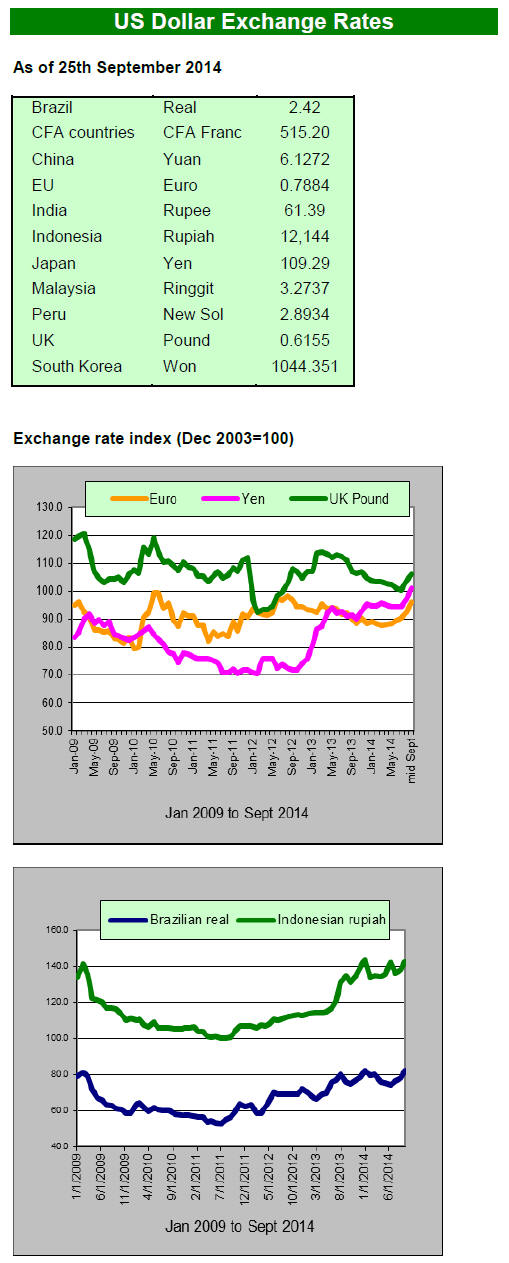|
1.
CENTRAL/ WEST AFRICA
Finely balance supply and demand
Over the past two weeks no price changes have been
reported for either logs or sawnwood. Analysts say it is
unlikely there will be any substantial change in the flow of
orders over the coming weeks.
However, reports are circulating that, due to the Ebola
outbreak, Liberia may suspend timber exports which will
result in a diversion of orders to countries that are less
affected.
At the moment supply and demand appear to be very
finely balanced against a background of generally weak
economic and market conditions in the EU but steady
demand from the Middle East and China.
EU demand unlikely to expand in final quarter
Producers are satisfied with the current order book
positions and consider these as about normal levels for this
time of year. They are now more confident about log
supplies and have indicated they could meet any increase
in demand from EU buyers should they begin to restock.
However, producers are not expecting any significant
change in the flow of orders from Europe.
The Ukraine conflict and sanctions on Russia are
beginning to weaken the economies of some EU member
states, particularly Germany and France, compounding the
impact of the depressed construction sector in many EU
member states.
The UK economy is in better shape than that of most EU
member states and the housing sector is very active. With
a general election due in May 2015 it is likely that the UK
government will continue with current fiscal policies.
Although recently there was an improvement in EU
tropical timber imports from the very low levels in the first
half of the year, buyers in the EU are uncertain of how
demand will develop in the final quarter of the year. The
pressure to tighten up on implementation of the EUTR is
just one factor that could depress growth in imports.
Meeting the tough specifications in quality and dimensions
is a major challenge for producers and this, coupled with
the very narrow range of species required for the EU
market, producers are keen to develop those new markets
which are open to a larger range of sizes and qualities as
profit margins tend to be better.
Boost to housing growth in China will benefit
exporters
Demand from buyers for the Chinese market is strong and
log and sawnwood prices have settled at around 15%
higher than the average in 2013.
The recent easing of credit flows in China and the actions
of regional administrations to boost housing growth could
benefit West African producers.
Producers report demand from companies in Vietnam is
good and the expansion of the woodworking and furniture
industries is encouraging.
The current market outlook is positive with the
expectation that the fine balance in supply and demand
will maintain the current price stability into the final
quarter of 2104.
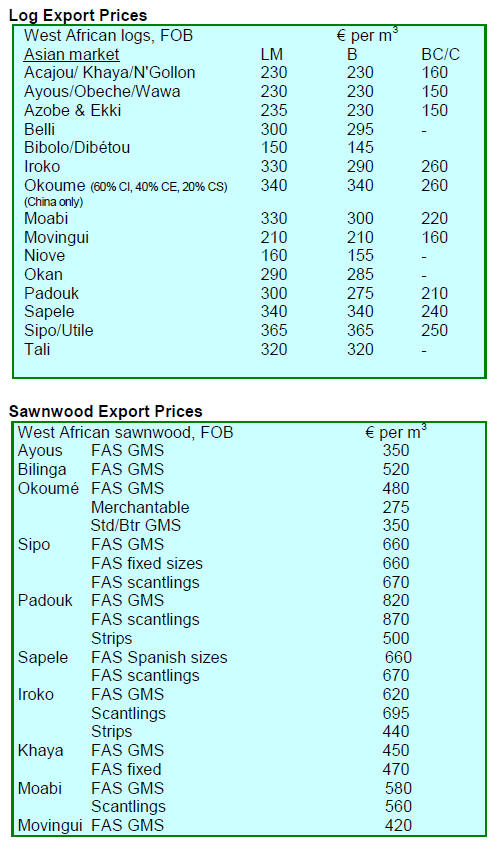
2. GHANA
Timber exports up 9%
According to data available from the Timber Industry
Development Division (TIDD) of the Forestry
Commission, Ghana‟s timber exports for the period
January to July climbed by just over 9% year on year.
The total export volume of 177,399 cubic metres for the
first seven months earned the country euro71.9 million;
only marginally up from the euro 71.56 million from
162,410 cubic metres in the same period last year.
Table below shows the wood product classifications
performance for 2014/2013.
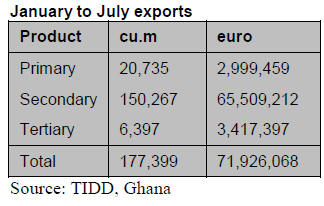
Secondary wood products accounted for 91% of the
total
wood export for the first seven months of 2014 and these
included air and kiln dry sawnwood, veneers, plywood and
blockboard.
Primary and tertiary wood products each accounted for
between 4-5% of exports during the period reviewed. The
export of poles increased to 4,688 cu.m from a volume 36
cu.m in the same period in 2013. Profile boards
(mouldings) exports doubled.
Commission launches REDD+ Campaign
The Forestry Commission (FC) plans to embark on a
REDD+ campaign aimed at drawing the attention of all
Ghanaians to the negative effects of Climate Change
which result from the destruction of the forest amongst
other causes. The Chief Executive of the FC made this
known at the launch of the campaign saying, deforestation
has been assessed as the third leading cause of global
warming.
REDD+ (Reduce Emissions from Deforestation and forest
Degradation) is an international mechanism that creates an
incentive for developing countries to protect and better
manage their forest resources to address Climate Change.
The FC chief executive hinted a „REDD EYE‟ campaign,
targeting the youth, would soon be launched to secure
their active involvement in series of activities to create
awareness for the REDD+ mechanism.
Relief for manufacturers as exchange rate stabilises
The cedi:dollar exchange rate was relative stable in the
second half of the month for the first time this year. At the
beginning of this year the cedi was trading at 2.70 to the
US dollar but fell to 3.78 to the US dollar in August.
Since then it has recovered slightly to between 3-3.25 to
the US dollar. This year alone the cedi has depreciated
against the US dollar by about 40 percent.
In a related development and because the depreciation of
the currency is having a serious negative impact on
industry, the head of the Association of Ghana Industries
said, while speaking at the opening of the first Industry
and Technology (Indutech) Fair in Takoradi, the
association will continue to seek better incentives for
domestic manufacturers so they can contribute to
sustainable development in the country.
BOG keeps interest rates on hold
The Ghana Central Bank has kept its policy rate
unchanged at 19% citing its forecast that inflation will
peak in the near future and then begin to fall to with the
Bank‟s target of 13% plus or minus 2%. Data from the
Ghana Statistical Service showed that year on year
consumer inflation rose to 15.9% in August 2014 from the
15.3% in July.
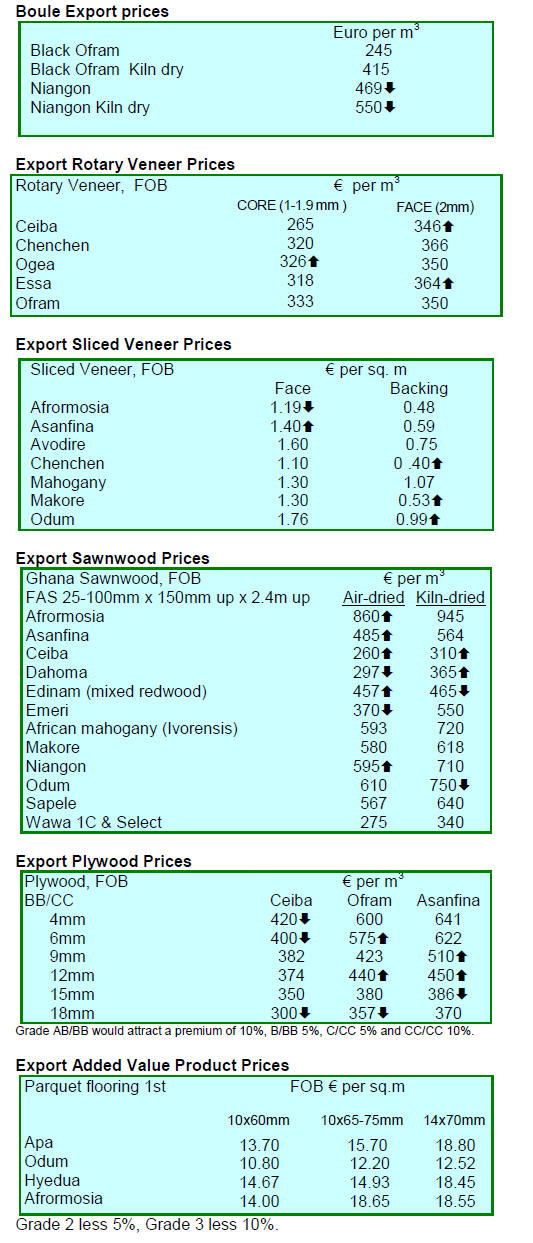
¡¡
3. MALAYSIA
MTCS endorsed for further 5 years
The Malaysian Timber Certification Scheme (MTCS) has
been reviewed and endorsed by PEFC International for a
further five years.
In a press release, the Malaysian Timber Certification
Council (MTCC) said: ¡°The re-endorsement of MTCS
means that the scheme has passed the most stringent test
and continues to meet the PEFC strict international
sustainability benchmarks.
The re-endorsement is an attestation of the robustness of
the MTCS. It further reaffirms and recognises the efforts
taken by the stakeholders in Malaysia towards achieving
sustainable forest management (SFM) and that the forests
certified under the MTCS are being managed
responsibly in line with globally recognised best practice
requirements¡±. See: www.mtcc.com.my/
PEFC International requires all national schemes to reexamine
their certification standards every five years and
revise them where necessary. The process of review
ensures that the latest developments in PEFC
requirements, new scientific information, practical
experience gained in the field as well as the expectations
and aspirations of society towards SFM are considered and
incorporated.
MTCC‟s Chief Executive Officer, Yong Teng Koon,
expressed satisfaction that the tremendous work which
MTCC had invested in the revision of the MTCS
documentation has been duly rewarded.
As of August this year there were 10 Forest Management
Units and two Forest Plantation Management units
certified and, when assessed in July, some 290 Chain of
Custody certificates had been issued.
Sarawak foresters armed to tackle illegal logging
Adenan Satem, the new Chief Minister of Sarawak,
signalled his seriousness in tackling illegal logging by
calling for the arming of enforcement agents. Fifty of the
most senior enforcement officers in the state‟s Forestry
Department are expected to be trained and then issued
with firearms from next month.
Additional resources will be provided to ensure the
operations of the Department remain efficient. The Chief
Minister has indicated the new anti-illegal logging effort
will be reviewed in six months and if progress in not
satisfactory more drastic measures will be taken.
Adenan, who became the state‟s fifth chief minister
recently, has pledged not to allow his immediate family
members to apply for state land or logging concessions
and has advised the state ministers to make a similar
pledge.
Export update from Sabah
The Statistics Department Sabah released the latest export
statistics covering the period January to July 2014.
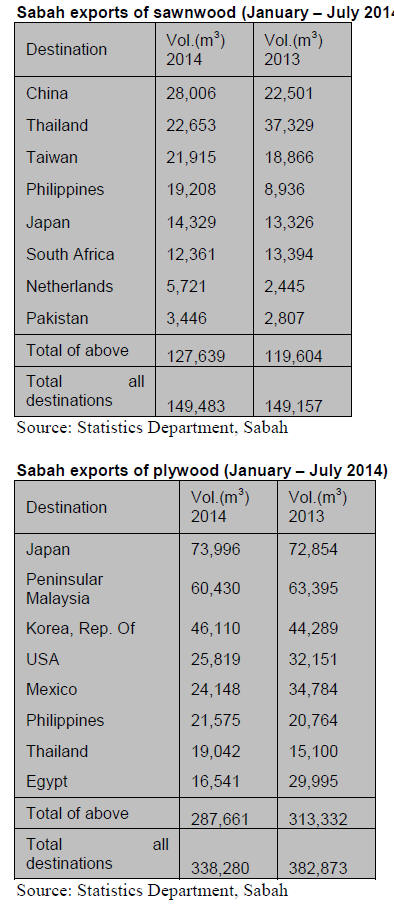
4. INDONESIA
Will Australia recognise SVLK
Indonesian Forestry sources are suggesting that
recognition of Indonesia‟s timber legality assurance
scheme (SVLK) by the Australian government may be
included in a memorandum of understanding to be signed
between Indonesia and Australia. This, said Dwi Sudharto
of the Ministry of Forestry, would pave the way for
expansion of wood product exports to Australia.
Australia has enacted a Illegal Logging Prohibition Act to
prevent illegal wood products entering Australia. If,
indeed, the SVLK is recognized as meeting the conditions
of the Australian then Indonesia‟s wood product exports
will get a boost.
5% of global furniture market in 10 years
The Indonesian Furniture Entrepreneurs Association
(Asmindo) is aiming to supply 5 percent of the world‟s
furniture demand within10 years.
Asmindo Chairman, Taufik Gani, said Indonesia‟s current
international furniture trade is small compared to countries
such as Vietnam, Poland and Brazil, which contribute
around 2 percent, or China which contributes around 30
percent to the world trade in wooden furniture.
It has been estimated that the Indonesian wood processing
industry employs around 4 million direct and indirect
workers making the sector one of Indonesia‟s priority
areas for development.
Previously, Asmindo had targeted US$2 billion in
furniture exports but this has been revised given the
success and international acceptance of the country‟s
timber legality verification system (SVLK). Last year, the
industry exported furniture worth US$1.83 billion.
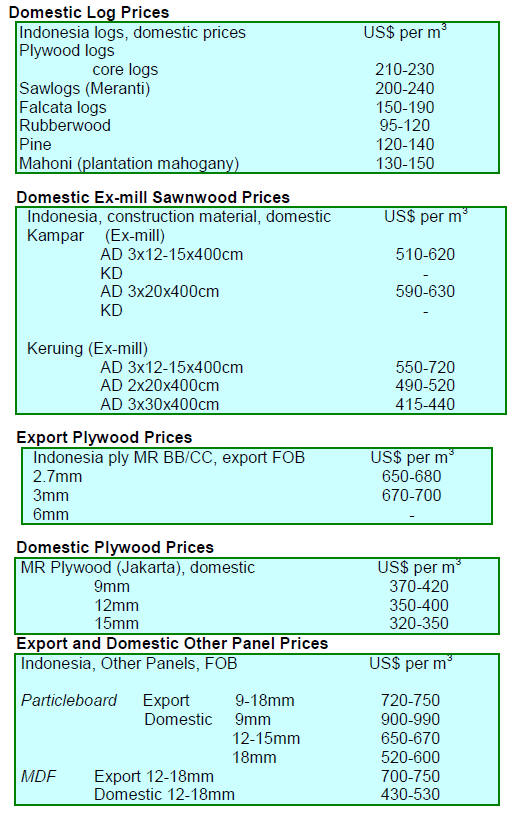
5. MYANMAR
Myanmar China cooperation on
deforestation
The Myanmar media (New Light of Myanmar) has
reported on a meeting between President Thein Sein and
Han Changfu, the Chinese Agriculture Minister.
Discussions focused on cooperation in prevention of
deforestation in Kachin State and prospects for expanding
exports.
Myanmar Kyat falls against US dollar
The Kyat fell sharply against the US dollar in late
September. The exchange rate at the beginning of the
fiscal year was about MMK 963 to the dollar. In May the
Kyat strengthened to 960 but has now fallen back and
stood at 991 on 26 September.
Analysts view this fall against the dollar with some
concern. While exporters may gain the price of essential
imports along with fuel will drive up production costs.
Forest Products Joint Venture Corporation open
tender
The Forest Products Joint Venture Corporation (FJV)
offered 2,051 hoppus tons of kanyin logs for sale by
competitive bidding on 24 September but only 492 tons
were sold.
The total income from the sale was MMK 211.285 million
(approximately US$435 per hoppus ton). Observers report
that the logs were reasonably fresh as they were harvested
within this fiscal year. The tender reserve price is thought
to have been around MM K425,000 per h. ton.
Considering the August FJV open tender resulted in an
average of US$537 per hoppus ton, the average price in
the September tender was disappointing.
Aalysts suggest that, if the reserve price had been
revealed, it is likely that more would have been sold. In
contrast to the FJV system, at MTE open tenders MTE
advise prospective buyers of the reserve price.
The photograph below gives an indication of the size and
quality of kanyin sold by FJV on 24 September.

Log harvests slashed
A senior official from the Forest Department has indicated
that the annual harvest for 2014-15 would be only 40% of
the harvest level in 2010-11.
This fiscal year only 670,000 tons of hardwoods and
60,000 tons of teak will be available for extraction.
Extraction in Homalin (Sagaing) and Tanintharyi areas
will be reduced and Bago area will be totally stopped.
According to a spokesperson from the Timber Merchants
Association (TMA), there are about 300 wood processing
factories in Yangon. Seventy TMA member companies
and 10 rattan factories are exporting to Europe, USA, and
Australia.
See:
ww.thetradetimesmedia.com/?p=8983#sthash.GKOz9RIP.
dpuf
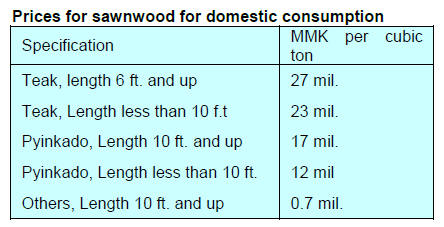
Tenders and sealed tender prices
The Myanmar Timber Enterprise (MTE) offered for sale
around 7,000 tons of teak logs and baulks of various
hardwoods on 26 September. Some of the lots were in
Yangon but most are outside of the city.
Prices (US$) secured in the sealed tender 26
September 2014
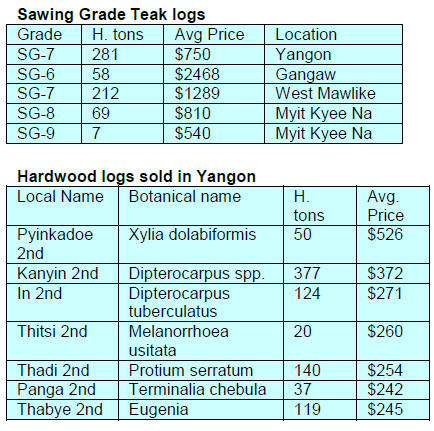 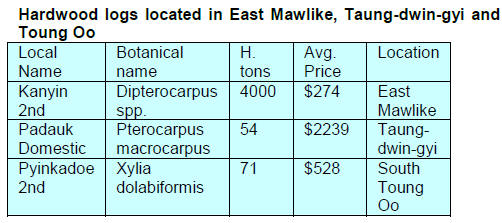
6.
INDIA
Wood product price index drops
The Office of the Economic Adviser (OEA) to the Indian
government provides trends in the Wholesale Price Index
(WPI). The official Wholesale Price Index for „All
Commodities‟ (Base: 2004-05=100) for the month of
August, 2014 rose by 0.6 percent to 185.7 (provisional)
from 184.6 (provisional) for the previous month. The
annual rate of inflation, based on monthly WPI, stood at
3.74% (provisional) for the month of August, 2014.
For more see: http://www.eaindustry.nic.in/cmonthly.pdf
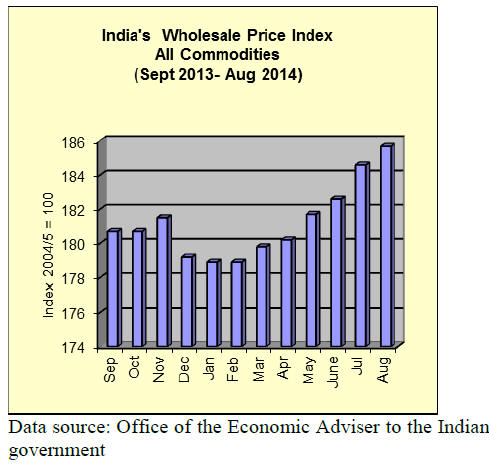
Timber and plywood wholesale price indices
The OEA reports Wholesale Price Indices for a variety of
wood products. The Wholesale Price Indices for
logs/timber and plywood are shown below. The August
2014 logs/timber index continued almost unchanged but
the plywood price index rose marginally.
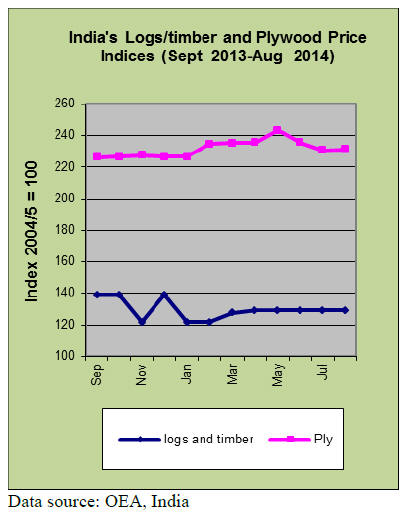
Update on Red Sander logs auction
The Andhra Pradesh government (AP) postponed the etender
e-auction of red sanders from September 19 to
October 10-17, 2014. The rescheduling was done to
facilitate visits by foreign buyers.
The company MSTC Ltd. (a subsidiary of Steel Authority
of India Limited (SAIL) was appointed to manage the sale
and was directed by the AP Forest Department to furnish
only the highest bid for each lot to the principal Chief
Conservator of Forests without disclosing the identity of
the purchaser.
The Government earlier announced the sale of about 8,584
tonnes of red sanders. In the first phase, 4,000 tonnes
would be e-auctioned with a reserve price of Rs.700,000
per tonne. So far, 415 prospective buyers have visited the
depots of which 249 were foreign of which 109 were from
China. Foreign buyers will be allowed to export the timber
from Chennai or any other port in the state.
Red sanders planting programme in Andhra Pradesh
The AP government is promoting the planting of redsanders.
In October the AP Forest Department will begin
raising red-sander seedlings and plans to distribute
between 10-20 million seedlings to farmers in the
Rayalaseema region.
A senior official said organised plantings on farms could
help increase the availability of this valuable timber and
also help reduce illegal felling and smuggling of redsanders.
Each farmer planting red sanders will be allowed
to sell for export 310 metric tonnes.
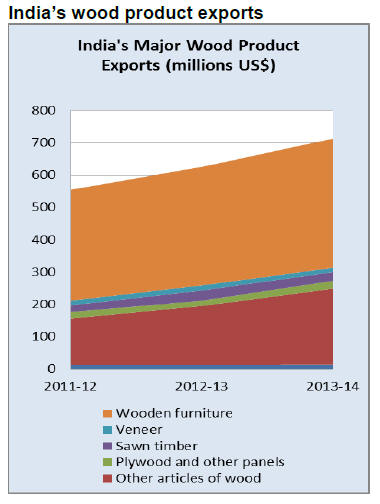
Value of wood product exports first half 2014
For the first quarter of the 2104/15 financial year exports
totaled US$173.7 million.
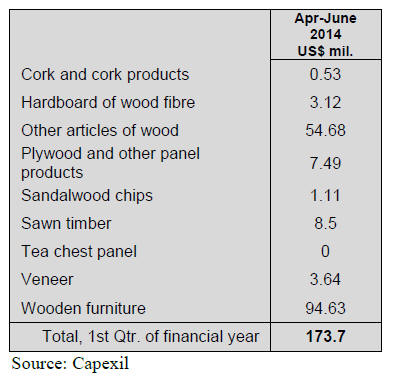
The trade feels that the performance of the timber
export
sector could be improved if the following were addressed:
Value added tax on sawnwood exports should be
lowered to 5% to improve international price
competitiveness.
Cochin Port should be included in the list of
permissible ports for log imports and export of
sawnwood produced from imported logs as
Cochin is one of the busiest ports on the Western
Coast. The inclusion of Cochin Port and
grouping this with Tuticorin and Mangalore ports
would benefit exporters of sawnwood in the
states of Karnataka, Kerala and to some extend
Tamil Nadu.
Waiver of Transit Permit (exporters‟ warehouse
to the port of shipment) for movement of
sawnwood destined for export. States such as
Andhra Pradesh, Tamilnadu and now Karnataka
are also allowing the free movement of imported
logs and timber as well as exports of sawnwood
without the Transit Pass. This change would
lower the transaction cost and eliminate the risk
of delayed shipments.
Eliminate the import duty on rough sawn timber
and lower the rate on processed timber and wood
based products to 5%.
Update phyto-sanitory rules and regulations to
align India‟s with those of other countries
involved in the timber trade and encourage wood
product exports to increase job opportunities.
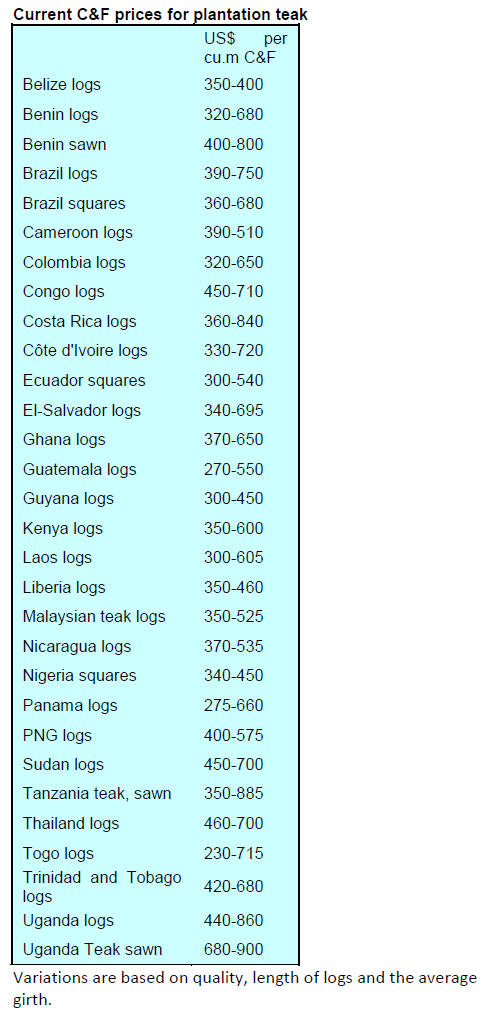 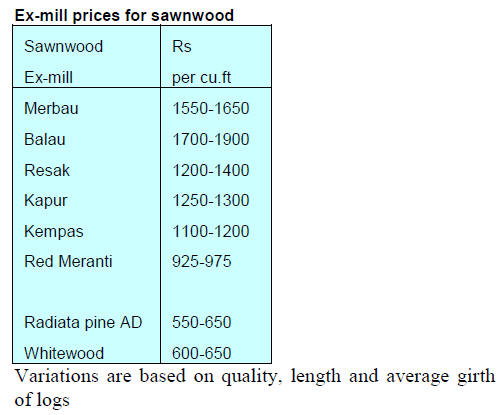
Rising prices for Myanmar timbers
Indian companies with remaining stocks of Myanmar
timbers keep are continually raising prices which
encourages end-users to look for alternative species.
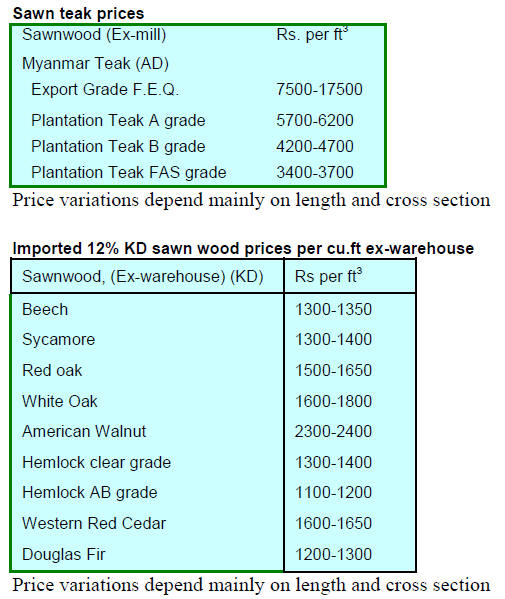
Plywood manufacturers squeezed
Manufacturers of paper laminates have increased prices by
3-4% as raw material costs are increasing and analysts
suggest further rises are likely.
Plywood manufacturers are also worried about the steadily
increasing costs of peeler logs from Sarawak as the
domestic plywood market is dull offering little prospect
for price increases. However, manufacturers are optimistic
that demand will pick up as agricultural has risen due to
the favourable weather during the monsoon and this leads
to higher overall consumer spending.
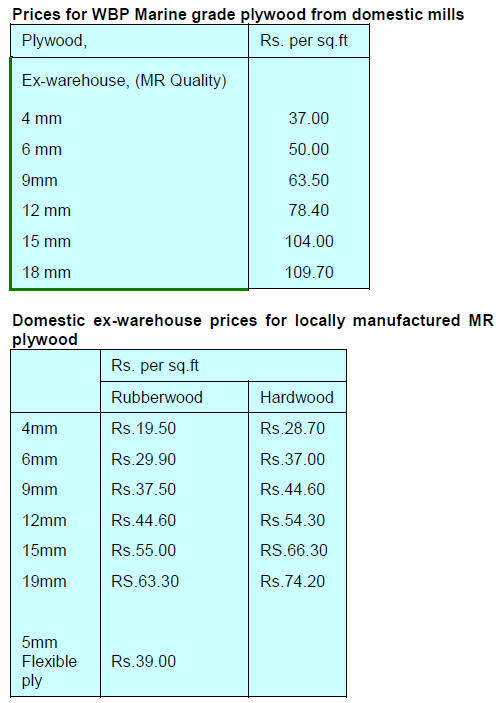
7.
BRAZIL
Tropical sawnwood exports rise
Rising demand for wood products in the main markets
serviced by Brazilian exporters is fueling optimism in the
Brazilian timber sector.
In August this year Brazil‟s tropical sawnwood exports
increased 9.0% in value and 11.4% in volume compared
to the same month last year.
The main markets were China (15.3%), the United States
(15.3%), Vietnam (9.5%) and France (8.4%).
China continues to be the main importer of Brazilian
tropical sawnwood followed by the United States,
Vietnam and India. Combined, these countries account for
nearly half of Brazil‟s exports of tropical sawnwood.
Tropical sawnwood export in August 2013 totalled 26,746
cu.m while in August this year exports rose to 29,795
cu.m. This year exports to India and Vietnam have been
growing fast.
Exporters in Par¨¢ state accounted for 27% of all tropical
sawnwood exports in August followed by Mato Grosso
(23.1%) and Rondônia (21.3%).
Furniture exporters seek to expand market share in the
US
Brazilian furniture makers are looking to expand exports
to the US and see the ORCHESTRA BRAZIL project as
core to this effort. The ORCHESTRA BRAZIL project is
the brainchild of the Brazilian Agency for Export and
Investment Promotion and Bento Gonçalves Furniture
Industry Association (SINDMÓVEIS).
Despite the increase in furniture production since 2000 the
Brazilian furniture sector has seen its international market
share fall due to competition mainly from Asian exporters.
ORCHESTRA BRAZIL is developing the competiveness
of Brazilian furniture companies for example by
supporting the creation of Brazilian designed furniture for
the American market.
In December SINDMÓVEIS will benefit from advice
from two US experts who will help link trends and
consumer preferences in the US with domestic capacity.
According to APEX - BRAZIL, in 2013 the US accounted
for US$47.3 million, out of the total US$148.2 million
exported by nearly 200 companies which are part of the
ORCHESTRA BRAZIL Project. In the first half of this
year exports to the US amounted to US$ 24.5 million out
of the total US$66 million exported in the first half of the
year.
The ultimate aim is for the project to have a physical
presence in the United States through retail outlets or as
partnerships with established brands.
August export trends
In August 2014, wood product exports (except pulp and
paper) increased 13% in value compared to August 2013,
from US$203.4 million to US$229.8 million.
Pine sawnwood exports increased significantly (up 39.5%)
in value in August 2014 compared to August 2013. In
terms of volume exports rose from 64,700 cu.m to 87,200
cu.m over the same period.
August pine plywood exports rose 7.3% in value in
comparison with August 2013, from US$33.0 million to
US$35.4 million. The volume of pine plywood exports
increased 91.600 cu.m to 96,800 cu.m during the same
period.
Tropical plywood exports also increased in August by
7.5% from 3,100 cu.m in August 2013 to 3,300 cu.m in
August 2014 (but still exceptionally low compared to level
of exports over the past 10 years).
In terms of value, tropical timber exports climbed 6.5%,
from US$ 5.3 million in August 2013 to US$ 5.7 million
in August 2014.
Wooden furniture exports in August 2014 were almost
unchanged from a year ago.
Forest regeneration through reforestation in
land
clearings
Researchers at the Brazilian Agricultural Research
Corporation (EMBRAPA) have reassessed a forest
restoration system in São Domingos do Araguaia in Par¨¢
state where a trial is underway as part of the Biomes
Project which aims at restoring natural forest cover on
denuded land through the initial planting of fast growing
species.
Among the species being tested are Schizolobium
parahyba and Swietenia macrophylla. Schizolobium
parahyba, known as the Brazilian fire tree or guapuruvu
tree (formerly used for dugout canoes) is used for toys,
boxes, shoe heels, the inner layers of laminated wood, and
paper.
The current survey aims to evaluate whether the
restoration of the forest canopy after planting with fast
growing species provides conditions for natural
regeneration of native species.
In the trial area regeneration of native species of
commercial interest (such as Dipteryx odorata, Pachira
aquatic and Handroanthus sp.) was observed. The recovery
system under study is simple and economically feasible
compared to alternative methods of restoration says
EMBRAPA.
Meeting of forest sector players in Mato Grosso
Representatives of the Brazilian forest sector gathered in
the state of Mato Grosso in early September to discuss
actions taken by the State including the implementation of
the Sustainable Forestry Development Plan of Mato
Grosso (PDFS); monitoring of Sustainable Forest
Management Plans (PMFS); the expected reduction of the
government‟s timber price list and attempts to create an
instrument to trace/certify the legal origin of Mato
Grosso‟s timber.
During the meeting representatives from the Center for
Wood Producers and Exporters of Mato Grosso (CIPEM)
pointed out the value of information exchange that takes
place in the sector such as monthly meetings with union
presidents. CIPEM is recognized by the Ministry of Labor
and Employment as providing guidance to the timber
sector on labour and legislation issues.
According to CIPEM, despite advances and improvements
in the state‟s forest sector over the past six years,
challenges remain. There is uncertainty on how the state
laws can be effectively applied and the environmental
liability in an industry which generates large volume of
residues. Doubts also exist in the minds of entrepreneurs
as to how state actions can lead to expand output of added
value timber products.
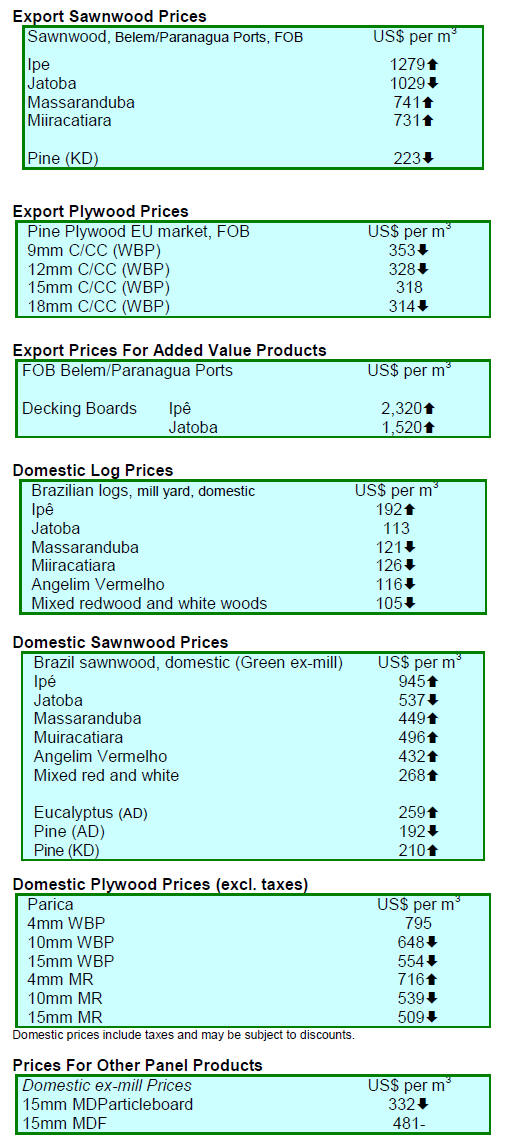
8. PERU
Final consultations on Forest Act
A total of seven organisations representing indigenous
peoples met on September 29 to finalise the preparation of
proposals for the Forest Act.
During the two-day meeting involving stakeholders
presentations and proposals were made by the various
working groups charged with addressing issues of zoning
forestry, forest management; forest and wildlife
inventories; wildlife management and water rights;
supervision, inspection and control: violations and
penalties; promotion for forestry and wildlife
management; plantations; management of forest through
concessions; use of wildlife and management in native and
rural communities.
Domestic construction sector gets stimulus boost
The Institute of Economics and Management (IEDEP)
within the Lima Chamber of Commerce (CCL) is
forecasting the domestic construction industry would grow
6.8% in 2014 driven by the stimulus provided to the sector
as the government moves to revive the economy.
C¨¦sar Peñaranda, IEDEP executive director said "Despite
its low share of global GDP (5.1%), the construction
sector is labour intensive, and is linked to many other
sectors. Moreover, since 2004, the sector has registered
high growth rates." Between 2009 and 2013 the
accumulated growth in the sector exceeded 60%.
See:
http://www.camaralima.org.pe/principal/noticias/3
Exports down in first quarter
Analysis by the Center for Foreign Trade (CCEX) of the
Lima Chamber of Commerce has shown that, in the first
half of this year, the value of exports totalled US18.132
million down 11% from the same period last year.
However, in terms of tonnage, exports increased by 9%.
From January to June, traditional exports totalled
US$12.617 million or 70% of all exports however, this
was a decline of 17% year on year. Of the traditional
sectors most affected were mining (-23%) and oil and gas
(-14%). The mining sector accounts for almost 50% of
total exports from Peru.
For more see:
http://www.camaralima.org.pe/principal/noticias/noticia/e
xportaciones-cayeron-11-en-el-primer-semestre/200
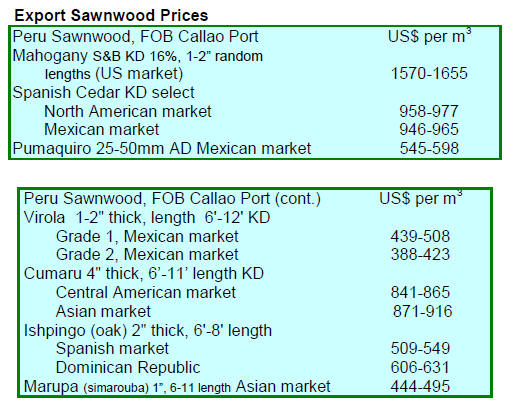 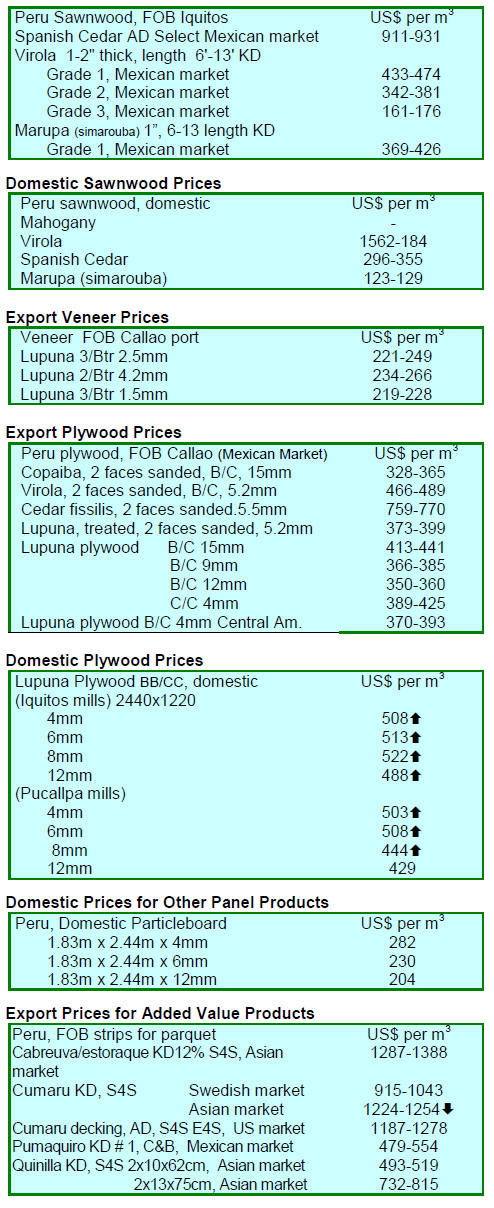
9.
GUYANA
New timber magazine from the Forestry
Commission
At the recent „Incentive and Investment Seminar‟ held at
the Guyana Forestry Commission Multiplex the Forest
Products Development and Marketing Council (FPDMC)
launched a new forestry magazine, „The Guyana Timber
Trade and Investment Magazine‟. The Minister of Natural
Resources and the Environment, Robert Persaud was on
hand to receive a first issue.
The publishing of the magazine stems from
recommendations in a report „Marketing Strategy for
Guyana‟s Wood Products Industry‟ and reflects the
thoughts and ideas of a number of knowledgeable
contributors‟ as it examines market and investment
opportunities.
The FPDMC says the aim is to encourage investment that
supports innovation and efficiency in the sector with a
particular emphasis on added value production, utilisation
of lesser used species and the introduction of market
opportunities.
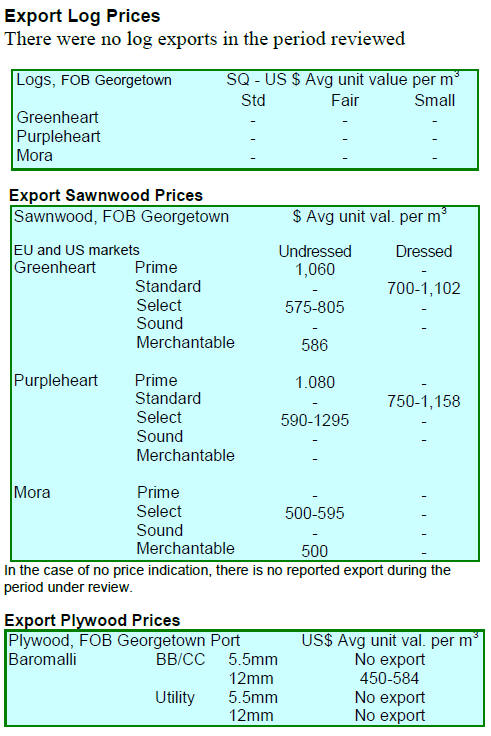
¡¡
|
